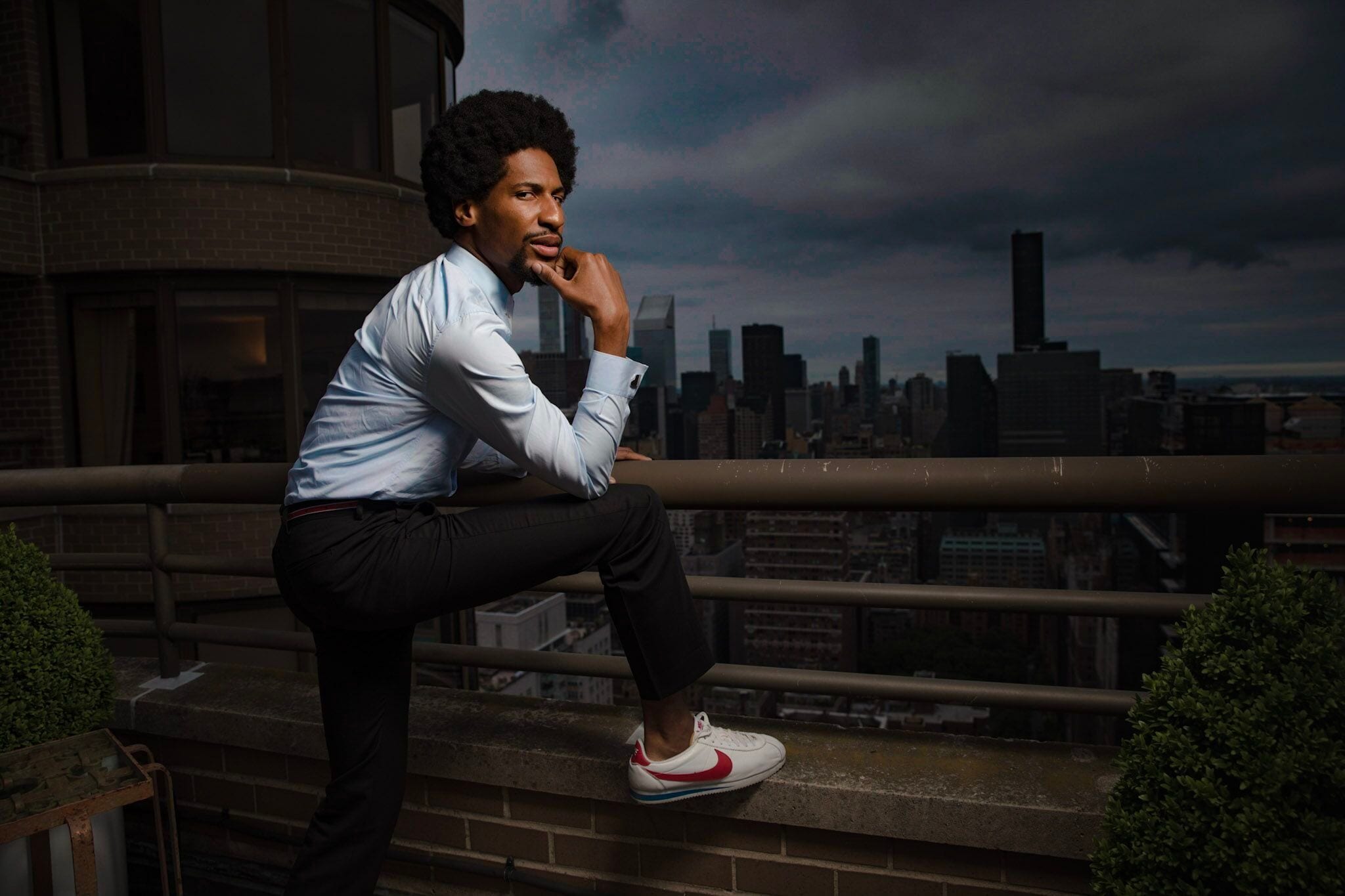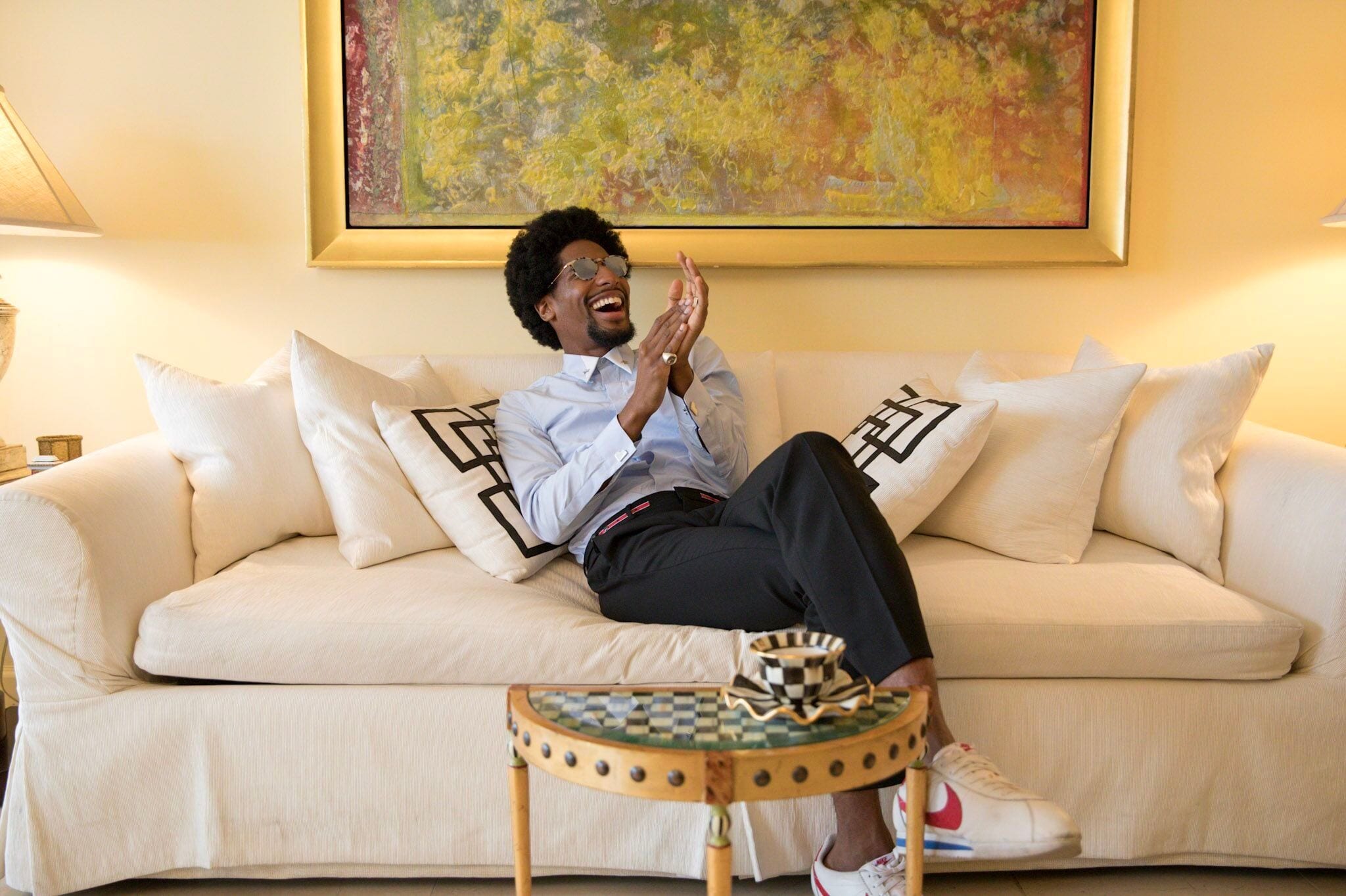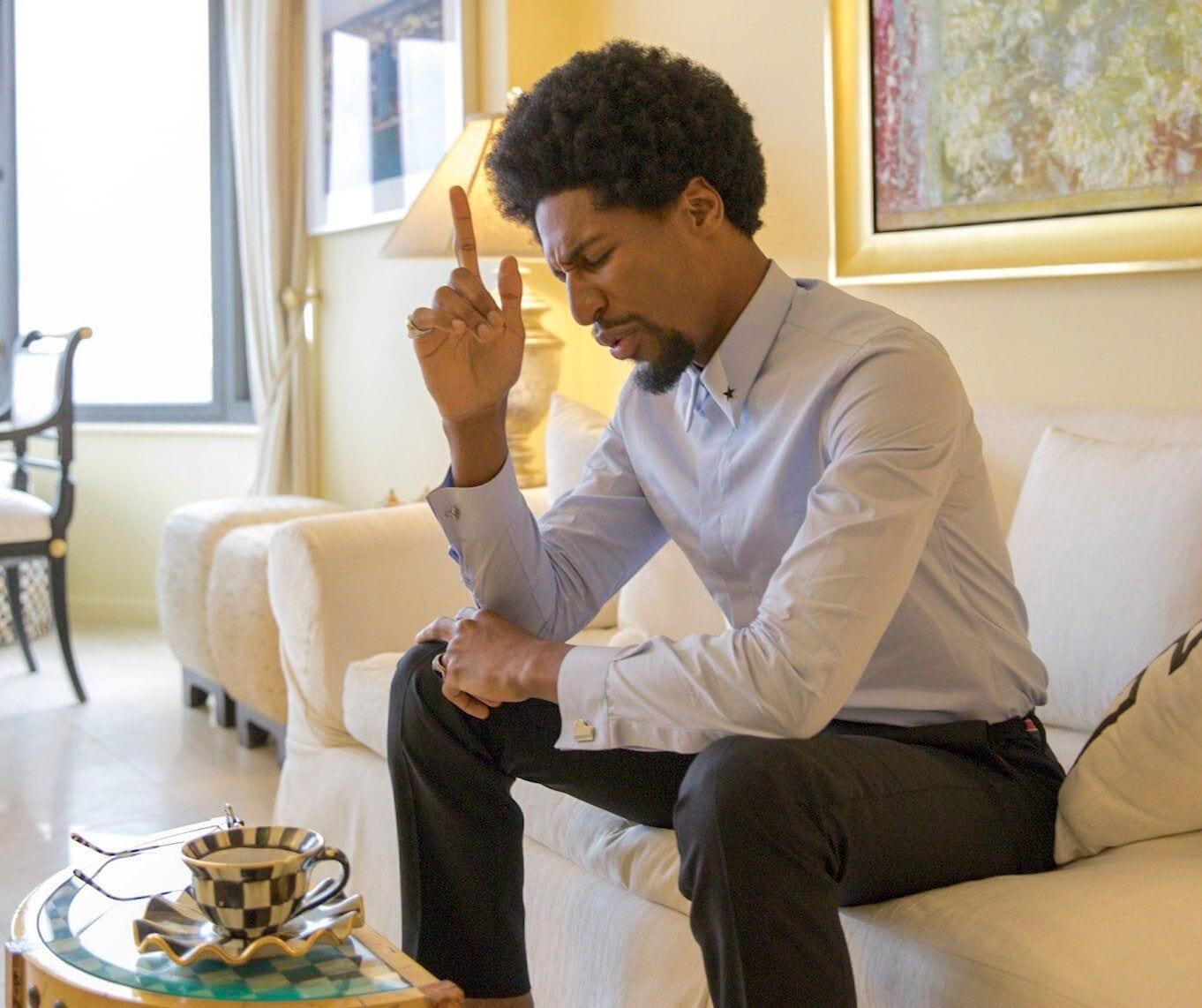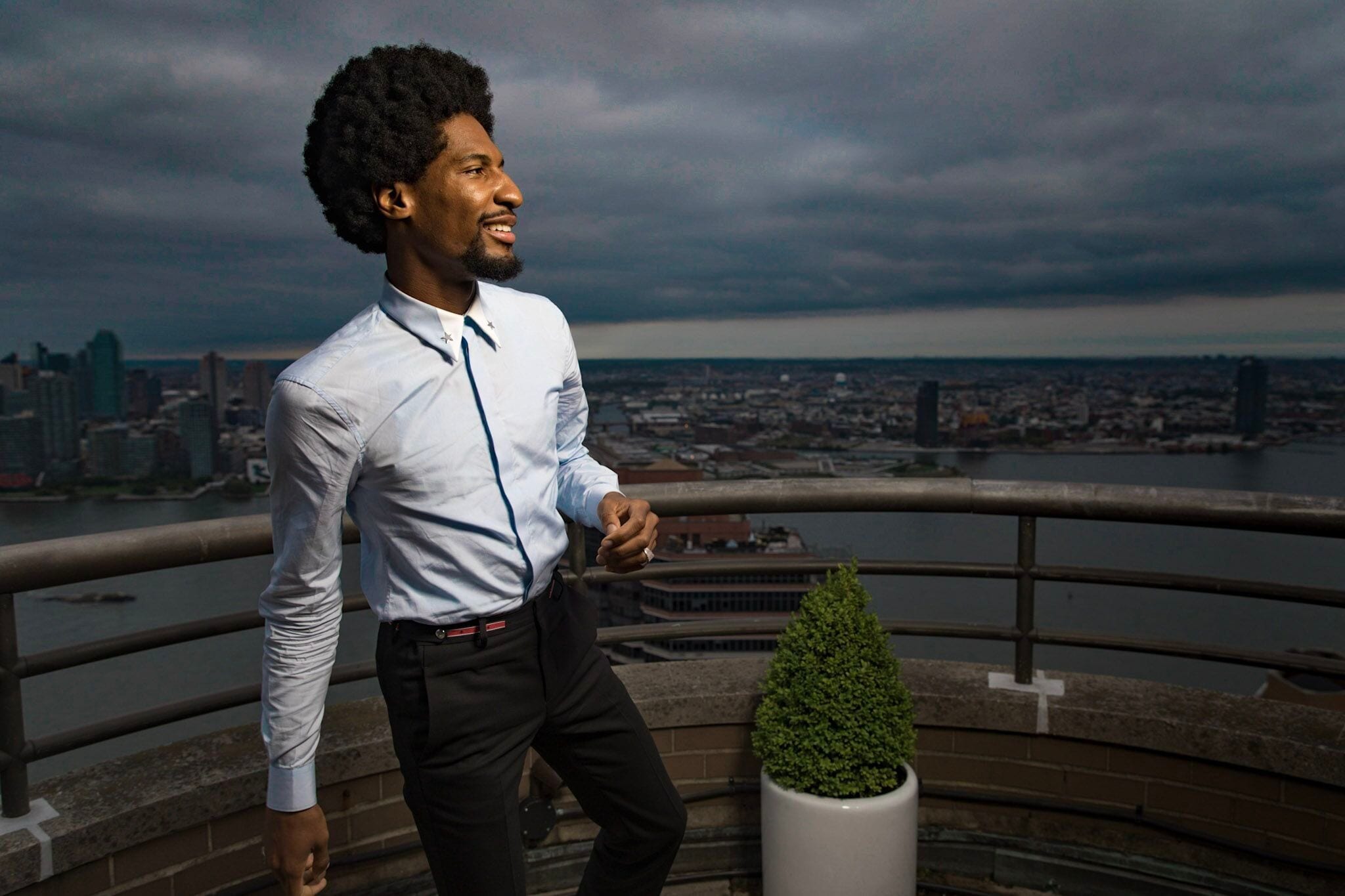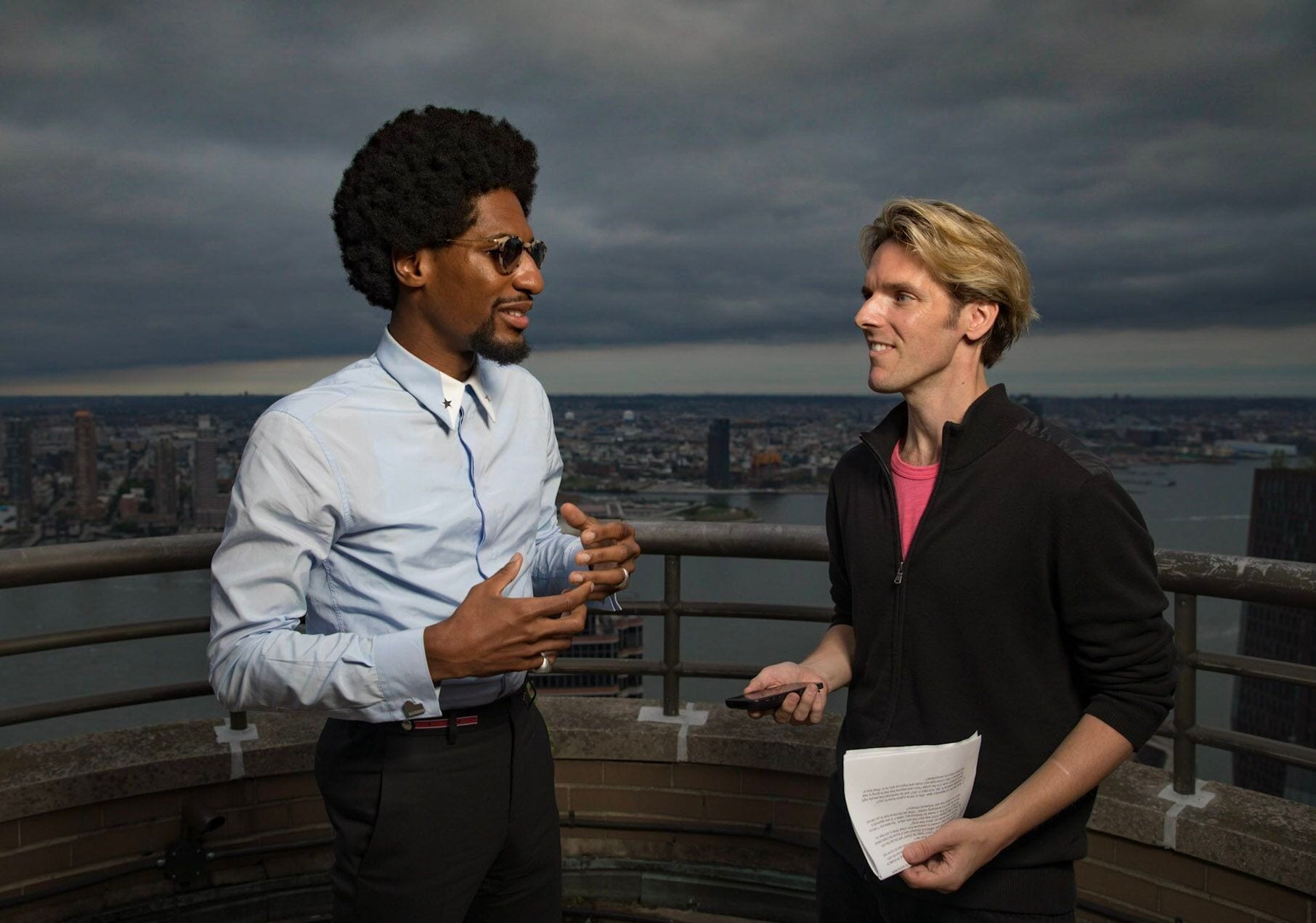
Jon Batiste speaks in musical notes. Mention the sparkling lights of Manhattan’s skyline, and he’ll respond with an improvised melody. Indeed, the sounds he creates in mere seconds brilliantly convey the Oz-like majesty of New York at night.
In sharing Batiste’s company, it’s clear that each moment holds the potential for music. Songs swim through his subconscious. “I feel like I’m writing them as I’m walking around,” he says. “When I sit down to put a song on the paper, it’s already done. I just have to get it out. That’s something I learned about myself only in recent years.”
His wellspring of ideas has grown exponentially since meeting veteran producer T Bone Burnett, whose unerring touch shaped the Grammy-winning soundtrack to O Brother, Where Art Thou? (2000) and Raising Sand (2007) by Robert Plant and Alison Krauss. Batiste and Burnett first connected at Bono’s birthday party in 2013. Over the next few years, they conducted a handful of recording sessions at Esplanade Studios in New Orleans, honing Batiste’s creative vision into Hollywood Africans (2018).
Hailed by Billboard as one of the “most anticipated albums of the fall”, Hollywood Africans is a richly detailed compendium of Batiste’s influences, crafted with reverence and love. It also weaves his musical forebears into a contemporary conversation. “They fought hard to have real rights that allowed me to be able to do what I’m doing,” he says. “I’m proud to be part of that lineage. The album’s an homage to the ancestors, but it’s also continuing to write that story.”
Batiste’s own compositions anchor half of Hollywood Africans. He plays with a maestro’s hand and sings with the heart of a poet, whether fueling “Is It Over” with raw emotion or fusing blues and classical on “Chopinesque”. A rollicking nod to his Kenner, Louisiana roots (“Kenner Boogie”) and a collaboration with songwriter Steve McEwan (“Don’t Stop”) bookend the album. In between, Batiste re-casts “Saint James Infirmary Blues” as a New Orleans funeral procession, wraps his voice around “The Very Thought of You”, and unveils the latent lullaby charms of “Green Hill Zone” from Sonic the Hedgehog.
“No pause, press play” Batiste gently commands on “Don’t Stop”, the album’s lead single. Those four words could also define the pulse of his career. In fact, Hollywood Africans arrives three years after Batiste began his current role as Musical Director for the Late Show with Stephen Colbert, leading his band Stay Human from behind the keys. Offscreen, Batiste’s own solo shows occasionally segue from the stage to the sidewalk. Curious bystanders invariably hear the festive tones of his harmoniboard and join what he calls a “love riot”, a pop-up music parade that often proceeds for several blocks, even on a brisk winter’s night.
Behind the scenes, Batiste is pressing play where it matters. Among his many endeavors, he currently presides as co-artistic director for the National Jazz Museum in Harlem and serves on the steering committee for the upcoming “Wonderful World: Friends of Music Therapy Gala” (15 October) to benefit the Louis Armstrong Center for Music and Medicine. As he prepares for a few appearances in Europe plus a batch of stateside tour dates, including a six-night stand at New York’s Village Vanguard later this fall, Batiste joins PopMatters for an intimate conversation about Hollywood Africans, the lineages that inform his music, and why he feels that songs are like people.
Earlier this year, I attended your solo in the round show at Bowery Ballroom. After almost every song, the look of joy on your face was so palpable, like a runner who’d just finished first place in a marathon. What goes through your mind in those brief moments between finishing a song and hearing the applause?
Release. Catharsis. You open up, man. The thing that you just played in the space? You feel it resonate in the air. Everybody’s feeling it. You feel how it’s transforming over the course of a night. The energy in the room evolves with each piece. That’s the beautiful part of live performance — you’ll never be able to imitate it with a machine.
What I loved about that show, and this is certainly reflected on Hollywood Africans, is that so much of it’s just you at the piano. In what way does the piano serve as your voice?
The piano was one of the instruments that I started with, and it’s my main instrument, so I feel very at home. It’s like a pair of shoes that you’ve worn so many times. They fit like nothing else, even other things your size. There’s just a certain contour that they have to your foot. It’s a special thing to have that kind of comfort on an instrument.
I don’t know if it’s necessarily different to other forms of expression, but I definitely feel a command of it. If I see a vision of a place or if I have any idea of something I want to convey or an emotion, I can do it just like that on the piano. I don’t want to say it’s easy, but it comes naturally.
You’ve noted how the album title Hollywood Africans is inspired by Jean-Michel Basquiat’s painting “Hollywood Africans” (1983). What was it about that painting that resonated with you on a personal level when you first saw it?
Seeing the painting has a lot of things that elicit a visceral reaction. It has a lot of global themes in there, in terms of the global exchange that happens when art and entertainment are commodified. You have a lot of themes of oppression and marginalization, minstrel themes, especially in African American entertainment, which is a part of what Basquiat was pointing out.
The painting is an indictment of the fact that we create all of these things in the world that are of value in many ways, but we have to wear a mask, or people appropriate things that have come from the African American community and make money off of them. I’m speaking to that but, more so, I’m speaking to the transcendence of that.
Irregardless of any sort of marginalization or oppression, or all the things that happened to try to block this music from coming into the world, it’s brought people together for generations and healed people across the world. The healing properties of that music is what makes me know it’s divine, which is what I put in the record and what I’m about.
Hollywood Africans opens with “Kenner Boogie”. What aspects of your hometown do we hear in the rhythm and melody of that piece?
It’s the way I interpret the feeling and the scene of being back home. The left hand is like a whole band, and the right hand is like a party. In the way it comes together, it’s the whole community. We go through a lot of the basic range of human emotions on the album, and I just wanted to start it in a place where we gather.
I’m going to jump around a little bit in the album sequence …
Of course! Yes. You listen to it in different ways.
When I heard “Saint James Infirmary Blues”, I remembered that you’d recorded it with Stay Human on Social Music (2013). That version thundered with music. It’s so interesting to hear you revisit it on Hollywood Africans, almost like a funeral procession. How would you characterize your approach to those two versions?
The song means a lot to me because it’s a song I learned early in my development. It’s something that you learn if you’re 11 years old and playing music in New Orleans. By the time you’re twelve, you know that song. If you’re playing in New Orleans, there’s a repertoire, “When the Saints Go Marching In”, “Li’l Liza Jane”. “Saint James Infirmary” is a part of those 20 songs that everybody knows.
When I did it with Stay Human, Michael Thurber helped me put the arc of the arrangement together. What I was doing was trying to create an outlet for the band to express the climax of angst and despair that you would feel if you were in the situation of the song, just completely crestfallen. That’s in contrast to what Hollywood Africans is about, which is more about making space to feel things, making space to think, and making space to just express those emotions.
The scene that I was creating on “Saint James Infirmary Blues” was a funeral procession. The Chopin piece (“Chopinesque”) sets the stage. The person who’s in the song can sense that something bad is on the horizon, but doesn’t know it happened yet. It takes this elegant melody, this graceful melody, and puts the blues through it. It’s like the love has gone to this place of despair. The song continues on to where you have the procession when you hear the horns and the drums come in, which is what happens in New Orleans. You have a dirge that brings people to home.
Yes, that’s exactly what comes through on “Saint James Infirmary”. You mentioned “Chopinesque” just now. I’d love to know how exactly you adapted the language of Chopin to your own musical vernacular.
That’s what the greats have always been able to do, take a melody and make it their own, and I just try to do it in my way. To me, songs are like people. If you look at a song, you can see a different side to that song, just like you can see a different side of a personality that maybe other people don’t necessarily see or haven’t taken the time to see. To me, I can hear the blues in something like a Chopin melody. Maybe other people who play it can hear other things in it.
It’s a beautiful thing to be able to approach a song that’s had a life, just like a person, and listen to what it has to say and then restate it or reinterpret it, almost in a way that you get deeper into the song, getting to know it better. You really are taking something that you’ve heard and speaking to it from a different angle. Whereas you may not necessarily be changing all of the notes, you’re changing the intention behind the notes. I love doing that. I just have a natural inclination to do that with certain melodies.
I’ve had the pleasure of listening to Hollywood Africans several times already. Earlier last week, around 1:00 a.m., I suddenly started humming this melody. I thought, I know this. What is it? Then I realized it was the introduction to “Mr. Buddy”!
Oh, man! Wow. [Sings melody to “Mr. Buddy”]
I love how that intro takes us by the hand and brings us into the world of “Mr. Buddy”. How do these characters come to life through the keys?
I’m always seeing a picture when I’m writing. That’s just the way I think, characters and pictures. On “Mr. Buddy”, in particular, I was thinking of the nostalgia of growing up and going to the playground, thinking about having a dog or a friend, and just the stories that you tell when maybe you separate from your friend or they pass away. Even if it’s not your dog or your best friend, it could be the community organizer or the janitor at the gym who took care of you. There’s a lot in the song. It’s just talking about friendship. Hopefully, people will have somebody like that in their life.
To me, “Nocturne No. 1 in D Minor” brings a dramatic flourish to the album. It reminds me of a tango. If that piece were a short film, what would the plot be?
If I were to make a visual for it, it would be a great dancer in a contemporary style moving along to these sounds and rhythms that are a part of the lineage of dance. You have the African influence in that. Then with the Spanish tinge, the Caribbean is a part of that … Trinidad, Haiti, Cuba. All of that music came together in New Orleans in a way that is really amazing but can also be modernized.
I feel like the record has a lot of songs, like “Kenner Boogie”, where you can dance to them in a way that could inform the culture. In fact, there’s a great dancer named Charm. She danced with Kendrick Lamar on the Grammy’s and we’d actually been talking with Charm about doing a video for the “Nocturne”, with just her dancing, similar to what we did with the video of “Don’t Stop”.
One of the more fascinating moments on Hollywood Africans, given the source material, is “Green Hill Zone”. In your hands, it’s like a lullaby. How did it occur to you to translate that from the video game context of Sonic the Hedgehog to the brilliant rendition we hear on Hollywood Africans?
I grew up playing video games. Being a kid, there’s so much that you’re absorbing. You don’t know you’re taking it in. It influences you for the rest of your life. The culture of New Orleans was part of my upbringing, but then growing up in my neighborhood in Kenner, I played video games for hours on end sometimes, just hours of me downloading this music from the game.
The Final Fantasy VII soundtrack or stuff that Yoko Shimomura would write, or just things from Sonic the Hedgehog, have these kind of nostalgic, genre-less melodies. Most games are taking all of this different stuff from the environment of the game and trying to make a song or theme around it. Like Final Fantasy, you go through this whole world that they create and all of these genres are blending in the soundtrack. Even on a fighting game like Streetfighter II, each stage is a different part of the world. There’s Brazil, China, Russia, California. In every stage, they wrote themes based upon where they were. That influenced my approach. When you’re nine years old, that’s when you’re getting a lot of information!
“The Very Thought of You”, of course, is a beloved jazz standard. Why do you think that song, in particular, has such a timeless appeal?
Because it’s love, and love is timeless. Love is something that, if we’re lucky, we experience it in spades. It’s a beautiful thing to have a person that you connect with like that. The song talks about when you see that person almost as if they were angelic. To feel that kind of affection for another person will never go out of style.
On the other hand, there’s this unrelenting ache in your delivery on “Is It Over”. What sort of release does that song give you?
It was great to record it because it was a release. That won’t go out of style, either! At first, I was kind of apprehensive about putting it on the record because it carries that kind of angst and depression that you go through. I don’t typically expose that, but I think it’s important to show the full range of the experience if you really want people to be able to heal.
I feel like that song can actually help you when you’re in the moment of it, to go deeper into it. At least in my experience, when I go deeper into the emotion that I’m feeling, it helps me flush it out. I feel like that song can help people the same way that a song like “What a Wonderful World” can help people to clear their mind or remember a loved one or have a sense of purpose, to see the world beyond the noise. I feel like “Is It Over” can help people get through the emotions that they’re dealing with.
I definitely hear that in your vocal, especially in the way you phrase “And she said yeah …”
In that part, I was thinking about how in eastern music and Arabic music sometimes there’s a wailing thing happening, almost like a yodel. I wanted to be able to channel that vocal device in a song, authentically, so that when it got to that point in the song, it made sense for me to sing that. It’s got to be real.
Ten years ago, I interviewed Janelle Monàe just after she’d recorded a version of “Smile”. She said her introduction to that song was through Stevie Wonder’s recording on With a Song in My Heart (1963). She responded to the lyrics and the purity in his voice. Though it’s a brief interlude on Hollywood Africans, what qualities do you respond to in “Smile”?
I really love the fact that, for one, Charlie Chaplin wrote it. To me, that song in so many ways encapsulates him. His whole thing is about reinvention and optimism, even though he dealt with a lot and he overcame a lot. That song is almost like a folk song. It represents so much of the experience of a certain group of people.
I wanted to have “Smile” on the record, especially after “Is It Over”, to point to a figure in history and give a nod to somebody who kind of represented what that is — “smile” — but also as a way for the end of the album to tell a story. Wherever the despair is, you can smile and continue to have faith on “Don’t Stop”.
Yes, “Don’t Stop” closes the album with a sense of hope and resilience. Explain the dynamic between you and Steve McEwan in writing that song.
We really helped each other structure “Don’t Stop”. We would sit down at the piano, and I would tell him what I’m going through. We’d put notes down. Then I would start playing whatever I thought that felt like. When I started playing, it came together in a way that’s almost mysterious. We’d start nodding our heads — “on man, this is in the zone” — then we just started to structure it.
Steve’s a great structural thinker in terms of suggesting “maybe a couple more bars here. The thing you said when you were telling me about x, y, and z situation, you should say that right here because then it will shine best.” It’s good to have another ear. You can have the raw emotion of what you want to say, but sometimes someone who’s detached from the situation can be a sounding board.
I know a lot of people who’d look at a song like “What a Wonderful World” and, based on what they’re seeing online, reading in the newspaper, or watching on the news about everything from the environment to the current administration, would feel that it’s a not such a wonderful world these days. How do you reconcile what’s happening around us with the lyrics to that song?
The negativity that we put into the world, the things that we do to the planet, is not great but billions of years of this planet existing in this way, in complete perfect symmetry, floating in space? That’s crazy! Just look at the stars in the sky or the cycle of life. You’re born, and then you learn from your grandparents and your parents, and then you give that to your kids, your family, your friends. If you look at nature, you can’t deny that there’s a greater purpose.
What made T Bone Burnett a good producing partner for you?
Oh my goodness. When I said I wanted to channel the ancestors and focus on the music, we started reading Zora Neale Hurston. That was his way of focusing. He kind of helps to focus the energy by first understanding the vision that I want to create and then creating an environment for me to really create in.
We went to this beautiful studio, an old two-story church/cathedral with 100-foot ceilings. We put the piano in the middle of the room and cut the lights off. We couldn’t even see each other. We were just conjuring the essence of this music. Sonically, he’s a master in getting the music that we capture to sound as immediate as it does as if you were in the room sitting underneath the piano. He captures the sound of the piano and my voice in a way where it’s like you’re there. That’s really hard to do. That’s another skill.
Yes, and we take that for granted as listeners. As an artist, that’s not always achievable, depending on who you’re working with.
Right, to sit and be able to hear something and know when it’s in just the right spot for you to start recording. We recorded most of the stuff in one take — two takes, max — of me playing and singing. No Autotune, no overdubs. To get that to work at the beginning of the recording process, you have to get the sound perfect so that you can then just go down song after song after song. He knew when the sound was in the right place. He knew when to stop tweaking.
A lot of times people will record and then, after the fact, they’ll edit with all kinds of computer programs to make it sound better. It’s hard to tell in the process but, in the result, you lose something with that. You lose a lot. If you’re trying to capture a performance, you got to capture it.
Now, this song is not on the album, but you recently performed “I Don’t Need No Doctor” with the Dap-Kings at Pier 17 in New York. Joshie “Jo” Armstead wrote that song with Ashford & Simpson and of course Ray Charles popularized it. What draws you to that song?
Having gotten to know Joshie is something that helps me really connect to her music. I have a record that I haven’t released with Joshie singing a lot of the songs that we toured with the Dap-Kings, who are funk/soul royalty. I’d heard “I Don’t Need No Doctor” before, but I’d never played it myself. It was something that I wanted to play after I met Joshie and worked with her. It was just special to me.
I’d like to end by going back to the very beginning. Times in New Orleans (2005) was your first solo album. At the time, AllAboutJazz described it as “a rare opportunity to sample the work of a developing master”. Thinking back to that first album, what did the future hold for you then?
I felt like I was just really fortunate to have my mother and father support the music that I was making. It allowed me the opportunity at 16 and 17 years-old to have my own band to put an album together, to explore these compositions that I was writing because most of the record was original music. I’d been composing and band leading since I was 15. To really think about the future? It was more just about the process and just loving the idea that this is something that I could do and build and see where it takes me. I didn’t even know where I would go with it, but I just knew I wanted to keep doing it.
And what does the future hold for you now?
Woooooo! Man, I’m just trying to stay so committed to things that make me feel authentically like me. Whatever I’m doing that makes me have that feeling, like I’m in my own skin … that’s it!
Photo: Sekou Luke Studio

